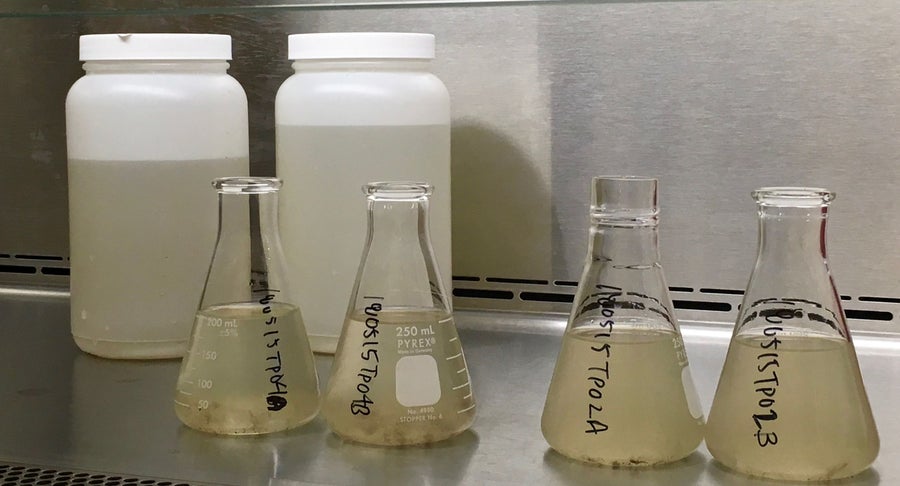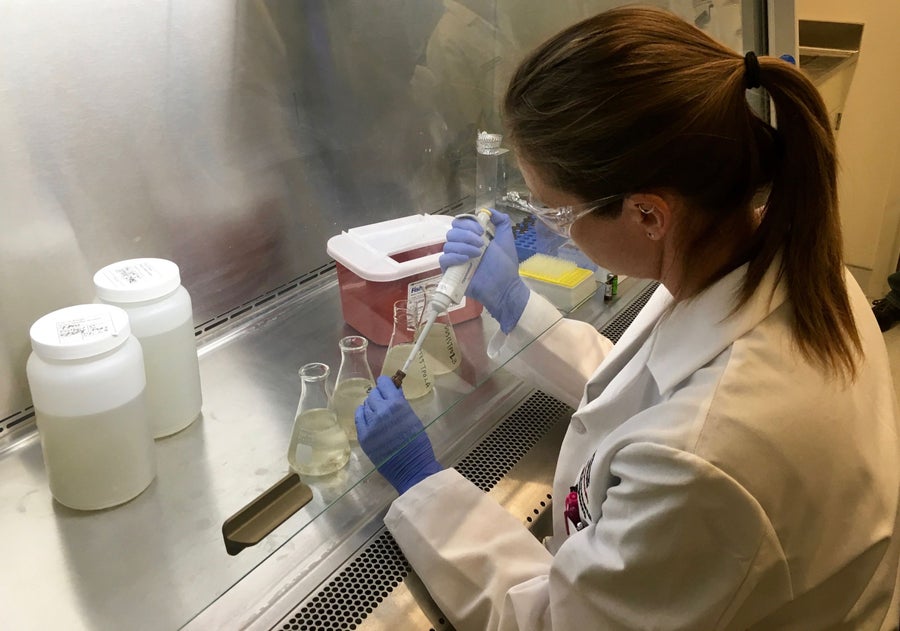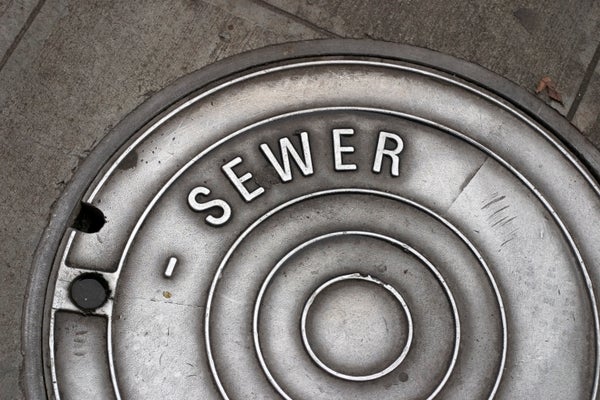TEMPE, Ariz.—The two-liter bottle of sewage sitting in a lab at Arizona State University is the yellow-brown color of smog. It was shipped overnight from one of a half dozen cities that have recently asked A.S.U. to begin studying their waste for chemical signatures that may help save lives. Such slurries of poop and urine have become one of the latest—and most pungent—ways communities are now trying to address the opioid crisis.
Sewage is “the information superhighway under your feet,” says Rolf Halden, director of A.S.U.’s Biodesign Center for Environmental Health Engineering. For the past 15 years Halden’s Human Health Observatory has examined such sludge in more than 300 municipalities worldwide, first at Johns Hopkins University and, since 2008, at A.S.U. His network—which includes partners in China, Australia and elsewhere—is the largest collection of wastewater monitoring sites on the planet. (The second-largest is in Europe, with about 60 cities.) For the past decade his A.S.U. team has been scouring sewage for clues about communities’ health: stress hormones, dangerous chemicals, dietary choices and nicotine. But as drug overdoses have risen to epidemic proportions—more than 63,000 in 2016—a growing number of cities have started to ask him to look for evidence of opioid use, too. “I think wastewater is a promising new tool that gives us another metric to [address] this problem,” says Daniel Burgard, a professor of chemistry at the University of Puget Sound, who is not involved in the work. “I don’t think it’s going to be the silver bullet, but with this epidemic I think using all tools possible is a good idea.”
Halden’s lab gives at least six municipalities monthly data on their residents’ collective intake of heroin, oxycodone, fentanyl and other opioids. Traditionally, public health officials rely on hospital data and surveys, which can take years to collect and are frequently unreliable. “History has taught us that when you ask people about drug use, you often don’t get a truthful answer,” Halden says. But “sewage doesn’t lie.” For example, from 2015 to 2017 A.S.U. researchers monitored two Midwestern cities with similar demographics, expecting to find comparable opioid use patterns. The toilet water told a different tale—one of the communities’ wastewater contained more than four times as much oxycodone.
On supporting science journalism
If you're enjoying this article, consider supporting our award-winning journalism by subscribing. By purchasing a subscription you are helping to ensure the future of impactful stories about the discoveries and ideas shaping our world today.

Studying sewage samples is helping some cities track the opioid crisis. Credit: Keridwen Cornelius
At the lab researchers run the sewage through liquid chromatography, which separates and organizes the chaotic compounds into straight lines, like students in a fire drill. Then the ordered solution goes through a mass spectrometer that has been calibrated to recognize each substance. The machine measures each drug’s abundance, and from these figures researchers can roughly estimate the number of doses for each opioid per 1,000 people. Halden sends some cities anonymous information about their general region’s opioid use whereas others request city-specific data to learn how they compare with other municipalities in the network. “With mass spectrometry, we can get a very accurate amount of a particular compound in the sample,” Burgard says. “One of the questions is: How representative is that sample of the population?” Shifting population patterns due to influxes of tourists, commuters and rapid urban growth can make it challenging to get absolute numbers for per capita drug use. He says looking at relative numbers is more useful, especially because sewage is such a fast way of tracking changes in drug use.
Halden’s researchers can analyze a sewage sample in a day or two, producing near–real-time data about the ebb and flow of specific opioids. That is crucial information for cities implementing interventions to control their epidemics. If a city shuts down a pill mill—a clandestine operation where medical workers inappropriately prescribe powerful narcotics—or arrests a ring of dealers, it can measure the immediate impact. If opioids start to disappear from the wastewater, it could be an early indication of success. But if the sewage is suddenly flush with fentanyl, it may indicate that legal users deprived of their prescriptions are seeking street drugs instead.
Dealers often lace street drugs with fentanyl, which is 50 times more potent than heroin—or even carfentanyl, an elephant tranquilizer 5,000 times stronger than heroin. Street and prescription fentanyls are too chemically similar to tease apart in sewage. But because the drug is so rarely prescribed, cities usually assume the problem stems from the street version, says Halden, who adds that his lab can distinguish fentanyl from analogs like carfentanyl.
If there has been a spike in dangerous drugs like fentanyl, officials can quickly alert first responders to stock up on the opioid antidote naloxone and be prepared to administer it in large doses (because standard naloxone levels that work well against heroin are oftennot enough to combat fentanyl). So “drug testing” wastewater could save lives.

Erin Driver, a doctoral student at Arizona State University, prepares sewage samples for further analysis. Credit: Keridwen Cornelius
Amassing Interest
Inspired by the success of sewage monitoring in Europe—which started in 2010 and included a wide variety of drugs—and the more recent promise of Halden’s efforts, Louisville, Ky., is now seeking government and private funding to participate in A.S.U.’s program. After overdose deaths surged to 364 in 2016 in surrounding Jefferson County, Louisville realized, like many cities, it had woefully underestimated its opioid crisis. “Even our most aggressive estimates fell short of the reality,” says Grace Simrall, Louisville’s chief of civic innovation and technology, who is tasked with bringing breakthroughs to city services including public health. “We needed a new source of data to be able to respond better, and earlier.” She thinks detailed wastewater data could help the city better predict how many clean needles and doses of naloxone to distribute, and where to locate drug take-back programs and medication-assisted therapy centers.
Other cities are also trying to integrate more poop studies into their opioid responses. On May 17, Tempe voted to fund a partnership with A.S.U. to integrate wastewater analytics into the decision process for drug interventions, tracking progress in real time. “To me, it makes perfect sense to have baseline data and follow-up data to make sure we’re really holding ourselves accountable for [programs] we’re implementing,” says Tempe Vice Mayor Robin Arredondo-Savage. Testing sewage for opioid levels “is a really innovative idea, and I think it will save lives,” she says.
One other city plans to audition a related approach: Cary, N.C., is teaming up with a Massachusetts Institute of Technology–affiliated company to scour the waste pipes with robots that suck up sewage, measure drug amounts and remotely report the data.
Wastewater can also help cities gauge the immediate impact of drug education campaigns. With surveys and meta-analyses, it can take more than a decade to determine if an initiative works. D.A.R.E. (Drug Abuse Resistance Education) was deemed a dud many years and billions of dollars after it launched. Sewage could have told us sooner if drug use was declining in school zones or neighborhoods where D.A.R.E. was implemented if had been tested in those areas, says Adam Gushgari, a postdoctoral researcher who says he is motivated to work in Halden’s lab because he lost two friends to opioid overdoses. “We would be able to adjust that program in a much shorter turnaround time,” he says. “Then we can really target our substance abuse programs to have truly marked change within our communities.”
Of course, the ability to pinpoint drug hot spots depends on the number of monitoring stations. Currently, most of A.S.U.’s sewage comes from wastewater treatment plants, where employees already scoop up samples to track compliance. They simply siphon off a portion and send it to the lab. It is also possible to tap into sewer pipes to get anonymous suburb- or neighborhood-specific readings. But that increases cost, which starts at about $10,000 a year per city and varies based on factors such as frequency of sampling and the list of metabolites measured.
Halden emphasizes this technology also tracks variables that could have an even greater impact on public health: outbreaks stemming from viruses or bacteria, smoking and obesity. His sewage sludge studies helped lead to the 2016 federal ban of triclocarban and triclosan—endocrine-disrupting ingredients in antimicrobial soap that do not break down easily and can end up in the blood, urine and breast milk. “Right now people are surprisingly skeptical of what one can measure in wastewater,” he says. But “I think this will become a common way of thinking in the future.”
Simrall agrees. “This could transform how cities deliver public health to communities,” she says. “I think we’re standing on the horizon of a brand-new way for delivering population health.”
